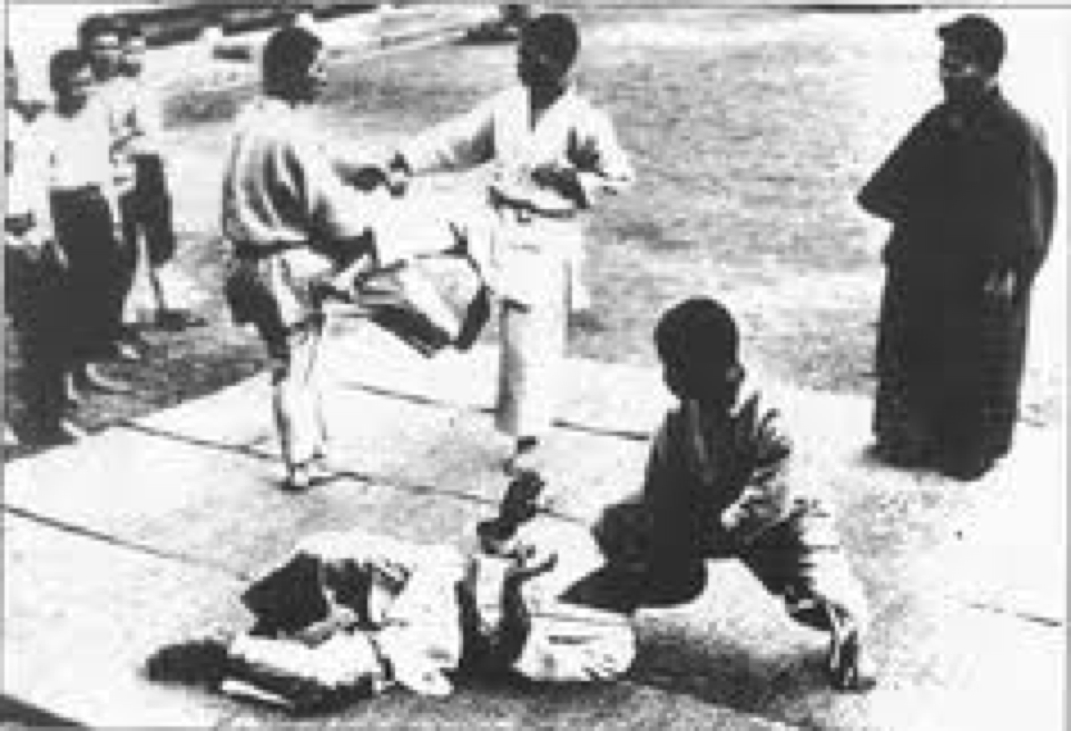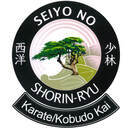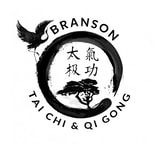|
In the beginning of Okinawan Karate or Te, as it was once called, there were no belt ranks. The people learned the martial arts out of necessity. The Island of Okinawa is situated between China and Japan. It was a hot bed of activity because it was a convenient stopping point for ships. This made Okinawa very valuable and it was constantly being raided by the Japanese and Chinese in their efforts to own Okinawa and gain the upper hand in shipping trade. The Okinawan people were constantly having to protect themselves and became very tough and adept fighters using the art of karate. In the end, Japan ended up owning Okinawa. (Today, Okinawa is considered a part of Japan much like Hawaii is part of the U.S.). During the birth of karate in Okinawa, most practitioner’s did not have belts, let alone uniforms. They simply practiced in whatever clothing they had. Usually, because Okinawa was very hot, they practiced in shorts or their underwear. Once karate started becoming popular they began wearing “Samurai under garments” which looked very similar to our modern Karate gi. One of the items of a Samurai under garment was a an obi, this was a cloth sash that wrapped around the waist several times with a purpose to hold ones pants up and secondarily to tuck in a knife (tanto) or sword (katana). The obi and gi traditionally were an off-white natural color because garment dyes were expensive and difficult to obtain. Bleach didn’t exist either, so clothing was the color of its natural, organic state.
One’s “rank” in early karate was apparent by how skillful and how long a person had been practicing in the art. Their age was also important to their status and rank. Age is still a vital part of respect in Japanese culture. Legend has it that the colored belt ranks may have developed over time based on the wearing of one’s originally white obi. As you practiced, over time it would yellow from sweat, get greenish from a combination of dried blood and sweat, turn brown from dirt and then turn black from years of use. Once black the cotton fibers would start to break down and fray which turned the belt grey and then back to white as the middle of the old cotton obi was exposed. So, in affect a karate practitioner goes full circle in their training. This is still the reason why today you will often see experienced black belts continue to wear a very old looking, frayed black belt that begins to turn white as the core of the belt is exposed. It is a symbol of experience and a master practitioner’s journey back to the full circle of a beginner’s mind… just like a white belt. Colored belt ranks, as we see them today, are a relatively new concept that is attributed with being originated by Jigoro Kano, the founder of Judo. Kano was an educator who worked for the ministry of education in Japan and used the belt rank system to integrate Judo and Kendo into the Japanese public school system around 1900. He also played a key part in Judo becoming an Olympic sport. Because of Judo’s popularity many other martial arts styles began to adopt a belt ranking system. Today, there are a rainbow of different colored belts and rankings depending on the style of martial arts you are involved in. Furthermore, the requirements to achieve rank are different for each school. Some martial arts schools award new ranks over years of training. Other schools, award ranks as quickly as monthly! Even the criteria for what qualifies a person for black belt is different from school to school. Unfortunately, this means that in some martial arts systems, a black belt can be achieved relatively easily by anyone… even a child under the age of 12. In the worst of the martial arts schools, you can pay your money and be guaranteed a black belt in 2 years or less, no matter what your capability. It is these schools or “McDojos” as they are sometimes called, that give karate a bad reputation. The nickname, McDojo is in reference to the fast nature of delivering rank similar to the fast-food franchise giant McDonald’s. In the best of the martial arts schools, earning rank is a long process that takes years of training and involves physical, mental and spiritual growth. Belt ranks aren’t something that one chases in hopes of achieving black belt as quickly as possible. But rather, rank is an honor that is earned through hard work, growth of character, lots of practice and constant improvement. The coveted black belt is not something that is easily achieved and not everyone will achieve it in a quality school. It definitely is not something that a quality school bestows around the waist of a child. A child has achieved neither the physical or mental maturity to earn the valued rank of black belt. It is also notable to realize that a first degree black belt represents that you are proficient and know the basics of your style. It does not mean that you are a karate master or an expert in the art. In most high quality karate schools, a shodan rank does not even qualify you to teach karate. Usually, that qualification is reserved for 3rd Dan ranks or higher. There is always so much more to learn and a black belt is just the beginning of what I like to call, “the fun stuff.” The black belt ranks, also called the yudansha level, are where you begin sharpening your techniques. Yudansha have the opportunity to learn more complicated skills, are introduced to new concepts, discover unique escapes, use additional weapons, often start training in other styles and begin understanding that karate is truly a way of life. Take this into your heart and mind, the martial arts are a journey to be experienced. When you commit to a quality karate dojo choose to walk the path without expectation of reward. Do it because you love the art NOT because you want to earn rank. Keep your ego in check. A belt is simply something to hold your pants up. Finally, remember this: “Anything can be bought or cheaply made, but that which is earned through hard work and sacrifice has the greatest and dearest value.” ~ Jim Harrison For those of you who are current or aspiring students of Seiyo-No Shorin-Ryu Karate & Kobudo Kai we have specific requirements for achieving each rank. Here is a primer to better understand the process of advancing in our art.
5 Comments
Knowing your past is necessary to moving towards your future.
Karate has a storied history. But, I find less martial artists truly know their roots. Shorin Ryu is an ancient Okinawan art. If you don't know much about Okinawa, karate or its history, this video provides a good foundation. It's amazing to learn that the same art we practice today shares deep roots with karate masters of the past. I hope you enjoy this video as much as I did: http://youtu.be/s83yIq4O5Sw If you enjoyed the video you may also enjoy seeing the lineage of our Seiyo No Shorin-Ryu organization. http://www.malineage.com/martial-artists/Vashon-Borich?section=lineage If you are compelled, sign up on malineage.com (it's free) and add your name to the lineage tree. The tracks each of us make may one day be a legacy. Honor your roots and make a difference in the future. |
AuthorVashon Borich-Leach, Sensei teaches traditional karate and tai chi in Branson, Missouri. She considers herself a life-time student of the arts. Her blog is an open journal of lessons learned in the martial arts. If you are a martial artist and would like to contribute to her blog please contact her. Archives
May 2023
Categories
All
©2012 Branson Karate & Kobudo™
|
©2010-2024 Vashon Enterprises LLC, DBA Branson Karate™

 RSS Feed
RSS Feed

